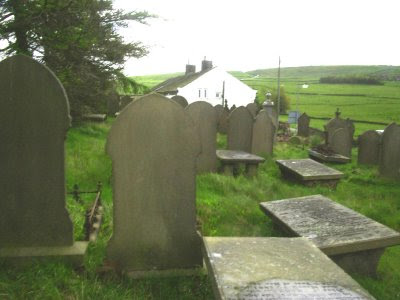Bancrofts from Yorkshire Strays 1881
I am sure many of our Bancroft researchers, whilst looking for ancestors from Yorkshire have drawn a blank because the people they are looking for have disappeared from the county.
Here's a list of Bancroft families from the 1881 census, where the head of household originated from Yorkshire but by 1881 was living elsewhere in England [not Scotland or Wales]
Have a look and sea if yours is there.
NAME ST S/M AGE OCCUPATION PARENTS BORN LOCATION
LANCASHIRE
STEPHEN H M 64 C.W.TWISTER JOS/ISABELLA OAKWORTH 40 ROBINSON ST,BURNLEY
HANNAH W M 66 WIFE HARDEN
ELIZ ANN D U 24 C/WEAVER HARDEN
EDITH ANN GD 9 SCHOLAR HOLBECKETHEL GD 6 SCHOLAR HOLBECK
MARY H W 71 L/HOUSE KEEPER HALIFAX 62 BONNY ST, LAYTON
RUTH H W 70 SEAMSTRESS WAKEFIELD 12 DAVIES ST,SALFORD
EDWIN H M 56 CLERK HEBDEN BRIDGE 25 WATERLOO ST,OLDHAM
MARY A W M 56 DRESSMAKER HEBDEN BRIDGE
CLARA A D U 24 DRESS ASS ROTHERHAM
JOHN H M 56 FARMER WADSWORTH LOWER PEMMIN,WARDLE
MARY W M 64 F'MERS WIFE CLITHEROE
HENRY H M 55 CORN DEALER HALIFAX 10 MOUNT PLEASANT,TODMORDEN
MARY A W M 55 HALIFAX
WILLIAM H S 13 FUSTIAN CUTTER CLIVIGER, LANCS
WILLIAM H H M 30 CARVER/GILDER SHEFFIELD 18 NEW PARK ST,BLACKBURN
MARY J W M 31 BIRMINGHAM
EDWIN T S 7 SCHOLAR BIRMINGHAM
FREDERICK S 6 SCHOLAR OLDHAM
HARRY S 3 SCHOLAR BLACKBURN
JONAS H M 40 STONE MASON JAMES/HANNAH BINGLEY 162 COLNE RD,BURNLEY
MARY W M 37 BURNLEY
HANNAH D U 17 C/WEAVER BURNLEY
CLARENCE S 15 C/WEAVER BURNLEY
ELIZABETH D 14 C/WEAVER BURNLEY
CLARA D 13 C/WEAVER BURNLEY
ROBERT S 11 C/WEAVER BURNLEY
JAMES S 9 SCHOLAR BURNLEY
ALICE D 8 SCHOLAR BURNLEY
FRANCIS S 6 SCHOLAR BURNLEY
BERTHA D 4 SCHOLAR BURNLEY
HANNETTA D 3 SCHOLAR BURNLEY
SELINA D 1 ?
JOSEPH H M 37 C/WEAVER JOHN/REBECCA DENHOLME MODEL LODGING
HOUSE,ACCRINGTON
ELIZ A W M 32 C/WEAVER BURNLEY
JAMES H M 46 GAMEKEEPER HALIFAX TOWNLEY,BURNLEY
SUSANNA W M 33 CLIVIGER
WILLIAM S U 20 SAWYER CLIVIGER
MARY ELLEN D 14 C/WEAVER TODMORDEN
EMILEY D 10 SCHOLAR NEW CHURCH
CROPLEY S 8 SCHOLAR HALIFAX
ELIZA D 5 SCHOLAR HALIFAX
MAY D 1 HABERGHAM EVE
TITUS H M 48 FORMER PUBLICAN JOSEPH/RACHEL BINGLEY 22 EDWARD ST,POULTON
BANCROFT W W 39 BINGLEY
HANNAH D 8 BINGLEY
ADA D 3 BINGLEY
THOMAS H M 51 COARD WAINER HALIFAX 46 HACKING TER,TODMORDEN
ELIZABETH W M 43 TODMORDEN
HANNAH J D U 21 C/SPINNER TODMORDEN
MARY E D U 16 C/SPINNER HALIFAX
SARAH E D 12 C/SPINNER TODMORDEN
MARGARET H W 52 HOUSEKEEPER LEEDS 3 IRK ST, OLDHAM
JOHN S U 17 WAREHOUSEMAN LEEDS
WILLIAM S 13 SCHOLAR OLDHAM
JOHN H M 52 C/WEAVER LUDDENDENFOOT WESTS VIEW NEWCHURCH
RD,NEWCHURCH
SUSAN W M 51 C/WEAVER NORLAND
ELIZABETH D U 27 C/WEAVER COTE HILL WARBY
MARY ELLEN D U 23 C/WEAVER NEWCHURCH
SARAH ANN D U 21 C/WEAVER NEWCHURCH
GRACE H W 52 ANNUITANT WARLEY GALE,CALDERBROOK
BETSY D U 16 ROCHDALE
ANNE D 9 SCHOLAR ROCHDALE
FLORANCE D 5 LITTLEBORO
WILLIAM H W 55 COTTON MANUF'ER KEIGHLEY 25 PALADINE SQ,HABERGH EAVES
WILLIAM H M 55 HOTEL KEEPER SHEFFIELD OLD RED LION
HOTEL,BURNLEY
MARIA W M 56 H/K'S WIFE ...HAMPDEN
THOMAS S U 20 DRAUGHTSMAN MANCHESTER
JAMES H M 26 C/CLOTHLOOKER STEPHEN/HANNAH OAKWORTH 139 ABEL ST,BURNLEY
FRANCIS W M 31
ELLEN D 3 BURNLEY
ANNIE D 1 BURNLEY
GEORGE
ALFRED
H M 26 C/WEAVER COTEHILl,WARLEY 65 NEWCHURCH OLD
RD,NEWCHURCH
ANN MARIE W M 24 TIPTON
FLORANCE B D 3 CLOUGHFOLD
JOHN
CHARLES S 1 CLOUGHFOLD
JOSEPH G H M 27 CORN DEALER S/MAN
poss ILLEGIT STANBURY 54 NAPIER ST,ARDWICK
MARY A W M 28 GRASSINGTON
DERBYSHIRE
JOE H M 30 SHOE MAKER LOXLEY GREEN LANE,DRONFIELD
JANE W M 27 DEINHEAD
HARRY S 5 SCHOLAR ROYDE
WALTER S 4 HASLAND
SARAH D 1 DRONFIELD
INGHAM L W 43 RAILWAY CLERK HALIFAX 44 BAINBRIGGE ST, DERBY
WERBURGH
WILLIAM L 11 SCHOLAR DERBY
AUGUSTUS L 5 SCHOLAR DERBY STAFFORD
HUDSON H M 26 COLLIER YORK 49 BROOK ST, BURNSLEM
SARAH A W M 29 BURNSLEM
SAMUEL S 5 SCHOLAR BURNSLEM
ABRAHAM S 3 BURNSLEM
ABRAHAM H M 22 COLLIER YORK 13 CLARANCE ST,BURNSLEM
MARIA W M 20 CREWE
WILLIAM T S 4M BURNSLEM
DURHAM
ARTHUR B 7 SCHOLAR BRADFORD 18 WILLIAM ST,DARLINGTON
WILLIAM H M 55 FOREMAN/QUARRY KILDWICK TROW ROCKS,HARTON
ANNE W M 50 SHIELDS
GLOUCESTER
MARY W M 40 C/MANS WIFE HALIFAX
MIDDLESEX
JAMES H M 52 CAB OWNER YORK 43 CHEYNE WALK,CHELSEA
MARY ANN W M 49 C/OWNERS WIFE NORTHAMPTON
JENNY D U 17 ACTRESS CHELSEA
ANNIE H D 12 SCHOLAR CHELSEA
MARY M D 9 SCHOLAR CHELSEA









































